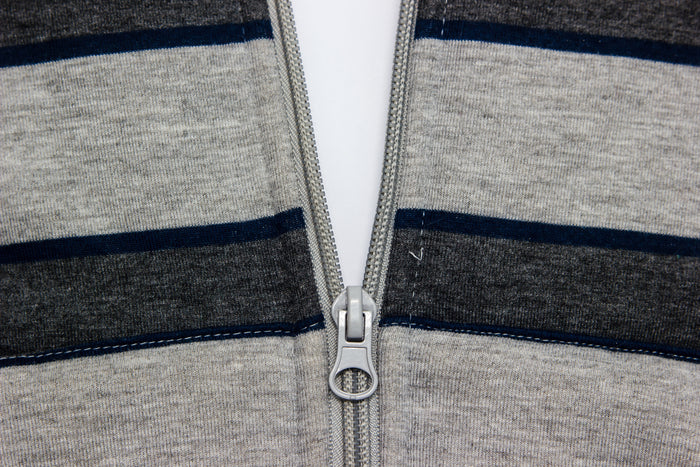8 Ways Zippers Can Help Improve Accessibility
Posted Monday, March 25, 2024

It’s easy to overlook the zipper as a run-of-the-mill component of clothing. After all, they’re common on jackets, hoodies, pants, and plenty of other things. But have you ever considered how useful they can be to improve accessibility, especially when added to items that might otherwise be difficult to wear?
Well, that’s exactly what we’ll cover in this article. Here at Zipper Shipper, we have many customers who buy our products to improve the accessibility of their clothing. Let’s look at how zippers can play a vital role in accessible fashion and design.
Why Are Zippers so Useful for Accessibility?
The core design of a zipper is incredibly useful for those with accessibility needs. This is because:
- Zippers can be scaled up or down in size to make them easier to use for those with limited mobility
- A zipper is far easier to use than buttons, laces, and other forms of closure you’d find on clothing
- Zippers can help widen pant legs, sleeves, and waistbands, making it far easier to get clothing on and off
The bottom line is that the humble zipper is pretty versatile in its use for improving accessibility. Considering the basic design is so simple and zippers always do the same thing, they can make a real difference to someone’s ability to wear what they want.
Improving Accessibility with Zippers
There are plenty of use cases for how zippers can help people with accessibility needs. As mentioned, we have plenty of happy customers who add our zippers to their clothing, so let’s look at some of the ways this can be done.
1. Zippers for Stroke Victims
Have you ever thought about which hand you use to open or close your zipper? All separating zippers have a hand designation – they’re either left- or right-handed, and this describes the side that the zipper slider runs up when worn. In short, if a zipper’s slider and box run up the right side of the tape when worn (meaning the insertion pin is on the left), it’s a right-handed zipper. If the slider runs up the left side, it’s a left-handed zipper.
This is an important distinction for those who might not have use of one of their hands – for example, stroke victims. A stroke victim without the use of their right hand may, for example, find a right-handed zipper nearly impossible to work with. While you can use a right-handed zipper with your left hand, it’s certainly more difficult.
Lining up the insertion pin and pulling the slider is harder when you’re doing it from the other side. It’s probably not something you’ve noticed if you’ve only ever used a zipper with 2 hands. But try it one-handed and you’ll see what we mean.
Whether a zipper is made to be right- or left-handed is determined at the time of manufacturing, so consumers don’t have a say on the product that they buy. This is precisely why you probably have a mix of right- and left-handed clothing items.
Luckily, most zippers can be modified to be either right-handed or left-handed.
2. Zippers for Medical Devices
Adding zippers to clothing can be really useful if you regularly have medical needs requiring IVs or catheters. This goes for things like chemo, too – basically anything that might involve a line being put in your arm.
Adding a zipper to your clothing for this really isn’t too difficult. Say you have a shirt or jacket you’re happy to wear for your appointments. Simply cut a small slit where the line will be inserted and then sew in a zipper. We recommend using a zipper gauge that’s compatible with your item of clothing. If the zipper will be going into a lighter garment, use a lightweight zipper (#2 - #4). If it’s going into something more medium-weight, use #5-#7 zippers.
The main reason for doing this is so you don’t need to fully remove your shirt during the procedure. Even if you only need to roll up your sleeve, having a hidden zipper will mean you can just carry on as normal. This’ll be helpful any time of year, but especially in the winter!
3. Zippers for Improving Independence
Getting dressed on our own is something many of us take for granted. Those with accessibility needs often need help getting dressed, especially for things like putting on pants and shirts.
Zippers can help maintain independence by simply making it easier to put on clothing. For example, replacing buttons with zippers means items can be done up without too much hassle. This is easy to do on pants, as it wouldn’t involve much work.
But what would this look like on a shirt or top? Well, you could split a shirt down the back and sew in a zipper. Something with a chunkier gauge (#5 and upwards) could work well for this. You might need to pair it with a long pull slider or pull tab though, just to make it as easy to use as possible.
4. Zippers for Amputees
Another popular use of our zippers is to adapt clothes for amputees. Generally, this means sewing a zipper into a pant leg to make it easier to fit over a prosthetic, particularly in form-fitting clothing like leggings or yoga pants.
Prosthetics can often be quite bulky, particularly where they fix onto the body. This can make it challenging to buy the right size in clothes, as they’d be loose everywhere but the prosthetic, or be too tight around it. Even trying to roll up a standard fitting pants leg can be difficult, whether or not you have a prosthetic!
Check out this video to see this tip in action. It’s super useful to add zippers to pant legs, especially if you need to access your prosthetic and don’t want to completely remove your clothing. Of course, the same logic can be applied to jackets, sweaters and other tops.
As for what zipper to use, this completely depends on the look you want. Invisible zippers, unsurprisingly, work well if you don’t want the zipper to be noticeable. The smaller gauge can work well on tops and pants made from thinner materials.
For things like denim, though, a chunky metal zipper can work well. Of course, this means the zipper will be more noticeable, but this isn’t necessarily a bad thing on denim. After all, it fits in well with the utilitarian nature of the material.
5. Zippers for Panels
Having panels in clothing can be a major help for those who might need access to a medical device but don’t want to move their clothing around. This is similar to the point about IVs above, except it’s for larger areas of clothing.
For example, sewing invisible zippers into tops can let you open a panel to access a stoma bag or similar. This saves you from having to completely untuck or remove your clothing in public, which is completely understandable.
Using bottom-separating zippers or two-way zippers can make it easy to access larger medical devices without affecting your modesty. Similarly, it can help to minimize discomfort and intrusion if you need help in a public setting or during medical exams.
6. Zippers for Adjustable Fits
Some medical conditions can result in fluctuations in size, especially around the waist. This might include dietary conditions, spinal cord injuries, and other conditions that can result in swelling and water retention.
Traditional waistbands on pants such as jeans or slacks typically don’t offer enough give. On the other hand, elasticated waistbands often need to be tight to hold the clothes in place, which can make them uncomfortable.
As such, adding a zipper into the waistband of pants or skirts can make it easy to adjust the fit between (or during) wears. Adjusting the zipper placement could make the item tighter or looser as needed to maintain comfort throughout the day. For this job, we’d recommend closed-end zippers.
7. Zippers for People Getting Scans
There are plenty of medical conditions that require regular scans, whether X-rays, CTs, MRIs, or anything else. Anyone who’s had a scan of this kind will know that you’re generally not meant to wear anything other than a hospital gown. And you certainly can’t wear any metal!
However, those who have regular scans often prefer to wear their own clothing, or it might not be possible for them to change into a hospital gown as needed. In these situations, adding zippers to clothing – or replacing existing zippers – can be a big help.
We recommend all-plastic zippers for this purpose, for obvious reasons. Provided you know your way around a sewing machine, replacing metal zippers with plastic ones is pretty straightforward. Making this simple change can have a big impact on your comfort when getting regular medical scans.
Here are a couple of ways to make an all-plastic zipper:
- Change the slider on an existing molded plastic or nylon coil zipper. Did you know that standard zipper sliders – even on plastic zippers – are made of metal bodies? Unless otherwise indicated, chances are that your plastic zipper has a metal slider. You can, however, replace the metal slider with a specialty slider with an all-plastic body. Currently, Zipper Shipper stocks all plastic sliders for molded plastic zippers in #5 and #10 sizes, and we stock all-plastic sliders for nylon coil zippers in #5 size.
- Buy nylon coil zipper chain or molded plastic zipper chain and pair it with a matching slider. This approach can be used for closed-end zippers only.
Please note – if you are looking to convert an existing zipper to an all-plastic one, it’s important to note that you will need to create your own top stops with thread since traditional top stops are made of metal.
8. Zippers for People with Arthritis
As we discussed previously, it can be quite difficult to undo certain fasteners at the best of times, particularly things like buttons, clasps, etc. This is especially true for those suffering from arthritis, and zippers can help make many items easier to grasp.
A sample of some of the projects we’ve seen:
- Replacing buttons on a duvet cover with a zipper. For this type of project, we recommend #5 nylon coil zipper chain + long pull sliders.
- Replacing clasps on a bra with a short separating zipper
- Replacing zipper sliders with standard pulls with ones with long pulls
- Adding a zipper pull tab or fabric swatch to a slider
Final Thoughts
As you can see, zippers can do a lot to improve accessibility in clothing. Whether it’s replacing buttons or laces or widening pants legs, the zipper’s core functionality is what makes it so useful.
We’re really proud to support people in taking their accessibility into their own hands (or on behalf of others). Where needed, we ensure our zippers are as easy to use as possible. So, check out our range to see what will work best for you, and please get in touch if you have any questions or need something you can’t find on our site.








